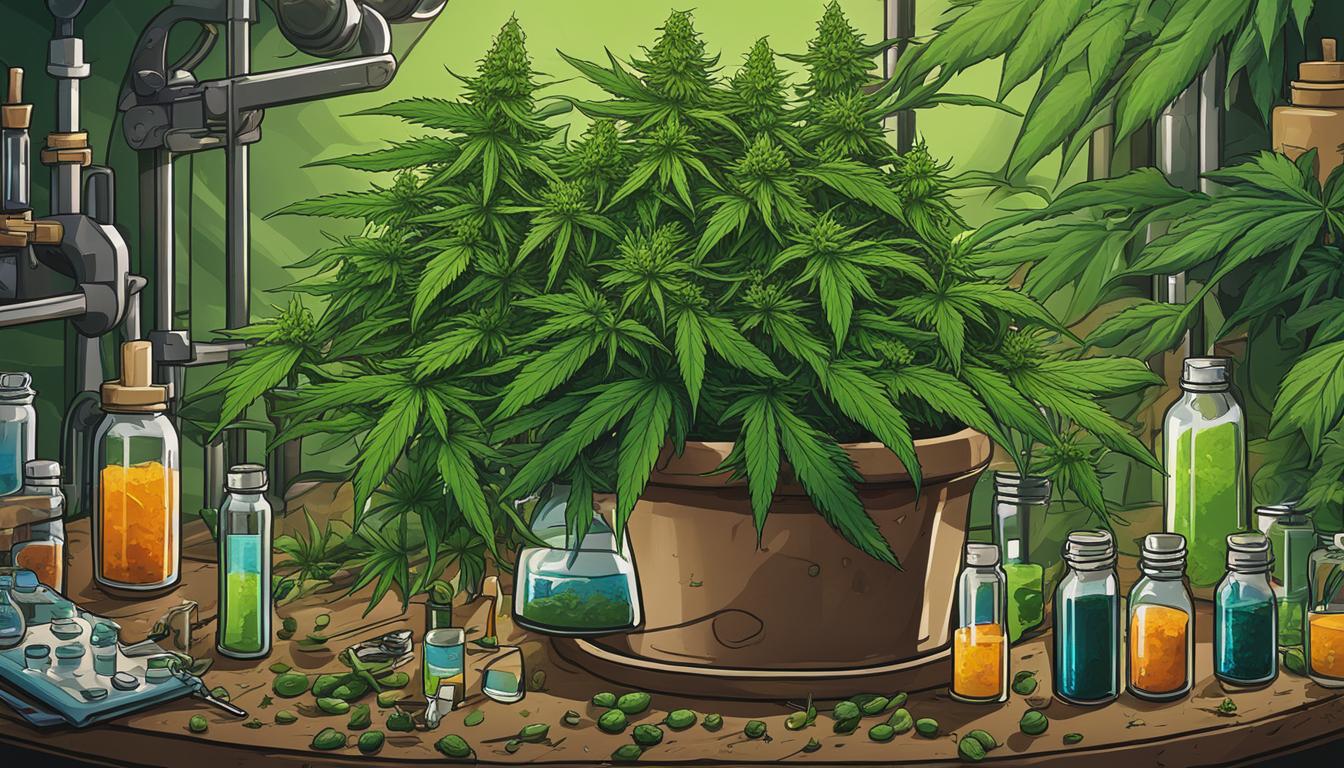As a cannabis grower, you know that the key to a healthy and thriving cannabis crop is proper nutrient management. Optimizing nutrient levels and understanding cannabis plant nutrition are essential to achieving robust growth and rich yields.
When it comes to nutrient management, there are several factors to consider, including the type of nutrients, the amount and frequency of application, and the pH level of the soil or growing medium. With the right strategies and techniques, you can maximize the potential of your cannabis plants, resulting in healthier and more abundant harvests.
Key Takeaways:
- Effective nutrient management is crucial for achieving robust cannabis growth.
- Optimizing nutrient levels and understanding cannabis plant nutrition are essential for success.
- Factors to consider in nutrient management include nutrient type, application frequency, and pH level.
- Maximizing the potential of your cannabis plants requires proper nutrient management techniques.
- Healthy and abundant cannabis harvests are attainable with the right nutrient management strategies.
The Basics of Cannabis Nutrient Management
When it comes to cultivating healthy cannabis plants, nutrient management is crucial. By providing the appropriate nutrient requirements, you can ensure that your plants develop and grow robustly. Here, we will discuss best practices for cannabis nutrient management and the specific nutrient requirements that promote healthy cannabis plants.
The Role of Nutrients in Cannabis Growth
Cannabis requires a balanced mixture of macronutrients and micronutrients for optimal growth. These nutrients are essential for the plant’s metabolic processes, including photosynthesis, water and nutrient absorption, and cell division. Understanding the function of each nutrient can help you tailor your nutrient management to your specific growing conditions and optimize cannabis growth.
Best Practices for Cannabis Nutrient Management
One of the essential aspects of cannabis nutrient management is understanding the plant’s nutrient requirements throughout its life cycle. During the vegetative stage, cannabis plants require a different nutrient ratio compared to the flowering stage. It is essential to provide the appropriate nutrient balance at each stage to avoid deficiencies or excesses that can impact plant growth negatively.
Additionally, identifying and addressing nutrient-related issues promptly can minimize the damage to the plant and ensure healthy growth. Keeping a regular nutrient schedule and monitoring plant health regularly can help maintain healthy nutrient levels and avoid nutrient-related problems.
Nutrient Requirements for Healthy Cannabis Plants
The primary macronutrients required for cannabis growth are nitrogen, phosphorus, and potassium. Nitrogen is essential for leaf development and vegetative growth, while phosphorus is critical for root development and energy transfer within the plant. Potassium is necessary for overall plant development, including cell division and disease resistance.
Secondary macronutrients, including sulfur, calcium, and magnesium, are also essential for cannabis growth. Sulfur aids in chlorophyll production, while calcium and magnesium help maintain structural integrity and enzyme activity within the plant.
Micronutrients, including iron, copper, and zinc, among others, are necessary for healthy cannabis growth. These micronutrients are required in smaller quantities but are crucial for specific metabolic processes within the plant.
Conclusion
By following best practices for cannabis nutrient management and providing the appropriate nutrient balance throughout the plant’s life cycle, you can ensure healthy and robust growth. Understanding the specific nutrient requirements and identifying and addressing nutrient-related issues promptly can help maintain healthy nutrient levels and optimize cannabis growth.

Maximizing Cannabis Growth Through Nutrient Management
To enhance the growth of your cannabis plants, achieving and maintaining proper nutrient levels is critical. By optimizing nutrient intake, you can boost overall plant development, improving the size and quality of your yield. Here, we will explore effective strategies to enhance cannabis growth with proper nutrient management, including:
- Choosing the right nutrient mix
- Adjusting nutrient levels based on plant stage and growth
- Monitoring nutrient levels regularly
- Ensuring proper pH levels for optimal nutrient uptake
- Using organic nutrients for improved plant health

To maximize growth, cannabis plants require specific nutrient ratios depending on their stage of development. During the vegetative stage, plants need higher levels of nitrogen to promote leaf and stem growth. In contrast, during the flowering stage, plants require more phosphorus and potassium to support the growth of buds and flowers. Throughout all stages, a balanced mix of nutrients is crucial to ensure healthy growth and avoid nutrient deficiencies or excesses.
Adjusting nutrient levels based on plant growth can be challenging, but monitoring nutrient levels regularly can make a significant difference. Test your water source, soil, and fertilizer levels regularly to maintain the optimal nutrient mix for your plants. Keep in mind that inadequate or excessive nutrients can cause stunted growth or even damage to the roots and leaves, so it is essential to maintain an appropriate balance.
Another crucial aspect of nutrient management is ensuring proper pH levels. To maximize nutrient uptake, it’s recommended to maintain pH levels between 6.0 and 7.0. Fluctuations in pH levels can decrease nutrient uptake, potentially leading to deficiencies or excesses, so regular pH testing is essential.
Using organic nutrients can also improve plant health and growth. Organic nutrients are derived from natural sources such as bone meal, kelp, and compost. These nutrients provide essential elements to the soil and promote healthy microbial activity, leading to improved growth and crop yield.
Tips for Enhancing Cannabis Growth with Proper Nutrient Management
Here are some additional tips for maximizing cannabis growth through proper nutrient management:
- Ensure proper drainage to prevent waterlogged soil, which can affect nutrient uptake
- Use a nutrient calculator to determine the appropriate nutrient levels for your plants
- Maintain proper temperature and humidity levels for optimal nutrient uptake
- Address nutrient deficiencies or excesses promptly to avoid further damage to your plants
By implementing these strategies, you can enhance the growth of your cannabis plants through proper nutrient management. Remember to monitor nutrient levels regularly, adjust nutrient mixes based on plant growth, and maintain proper pH levels to achieve healthy and robust cannabis growth.
Understanding Nutrient Deficiencies and Excesses
One of the key components of successful cannabis plant nutrition is maintaining appropriate nutrient levels. However, some growers may experience nutrient imbalances, which can result in deficiencies or excesses. Understanding these common imbalances and their effects is essential for maintaining the health of your plants and optimizing robust growth.
Nutrient Deficiencies
Nutrient deficiencies occur when a plant lacks a specific nutrient that is essential for its growth and development. Identifying deficiencies early is crucial to prevent more severe damage to the plant. Common signs of nutrient deficiencies include yellowed or discolored leaves, stunted growth, and reduced yields.
| Nutrient | Symptoms of Deficiency |
|---|---|
| Nitrogen (N) | Yellowing of leaves, stunted growth, reduced yield |
| Phosphorus (P) | Purple or red leaves, stunted growth, reduced yield |
| Potassium (K) | Yellowing at the tips of older leaves, brown spots, reduced yield |
| Magnesium (Mg) | Yellowing between the veins of leaves, stunted growth |
| Calcium (Ca) | Brown spots, distorted leaves, reduced yield |
| Sulfur (S) | Yellowing of new growth, stunted growth |
| Iron (Fe) | Yellowing between the veins of leaves, stunted growth |
It’s important to note that nutrient deficiencies can occur even if the nutrient is present in the growing medium. Factors such as pH levels, temperature, and water quality can affect nutrient availability, leading to imbalances.
Nutrient Excesses
Nutrient excesses occur when a plant receives too much of a specific nutrient, which can be just as harmful as a deficiency. Excess nutrients can lead to toxicity, causing damage to the plant’s roots and inhibiting growth. Common signs of nutrient excesses include burnt or darkened leaves, stunted growth, and reduced yields.
| Nutrient | Symptoms of Excess |
|---|---|
| Nitrogen (N) | Dark green leaves, soft growth, reduced yield |
| Phosphorus (P) | Stunted growth, burnt tips, reduced yield |
| Potassium (K) | Yellowing at the tips of leaves, brown spots, reduced yield |
| Magnesium (Mg) | Leaves curling and drying out, reduced yield |
| Calcium (Ca) | Distorted leaves, reduced yield |
| Sulfur (S) | Wilting leaves, reduced yield |
| Iron (Fe) | Burnt tips, yellowing between the veins of leaves |
Preventing nutrient deficiencies and excesses involves careful monitoring and management of nutrient levels, as well as maintaining appropriate growing conditions. By understanding the signs and symptoms of these imbalances, you can take proactive measures to maintain healthy nutrient levels and promote robust cannabis growth.
Nutrient Delivery Systems and Techniques
Effective strategies for cannabis nutrient management are crucial for achieving robust growth. Even with optimal nutrient levels, proper delivery techniques are essential to ensure your plants receive the necessary nutrients. Here are several techniques to help enhance nutrient uptake:
Hydroponics
Hydroponic systems have become increasingly popular in the cannabis industry, and for good reason. Hydroponics provides a highly efficient method of delivering nutrients to your plants. This technique involves growing plants in nutrient-rich water using a variety of methods such as deep water culture (DWC) or ebb and flow systems. Water uptake is directly related to nutrient uptake in a hydroponic setup, making it a highly effective strategy for cannabis nutrient management.
Soil
For growers who prefer soil-based growing, the proper preparation and conditioning of soil can make a big difference in nutrient uptake. To maximize nutrient delivery, it is essential to ensure the soil is properly aerated, contains the appropriate nutrients, and has a balanced pH level. Adding organic matter like compost or manure can also boost soil health and provide a slow-release source of nutrients throughout the growing cycle.
Foliar Feeding
Foliar feeding is the process of delivering nutrients directly to the leaves of the plant. This technique is useful for addressing nutrient deficiencies or boosting nutrient uptake during the flowering stage. It is important to note that foliar feeding should not replace regular nutrient delivery methods as the primary source of nutrient uptake.
pH and EC Monitoring
pH and Electrical Conductivity (EC) monitoring are critical for maintaining proper nutrient uptake. Keeping the pH level within the optimal range (between 5.5 and 6.5 for soil-based growing and between 5.5 and 6.0 for hydroponic setups) is essential for ensuring the proper availability of nutrients. EC measures the concentration of nutrients in the growing medium, allowing growers to ensure that the plants are receiving the appropriate levels of nutrients throughout the growing cycle.
By using effective strategies for cannabis nutrient management and ensuring proper nutrient uptake, you can maximize robust cannabis growth and achieve healthy, luscious yields.
Understanding Nutrient Deficiencies and Excesses
It is essential to maintain proper nutrient levels for robust cannabis growth. However, it’s just as important to prevent nutrient imbalances, which can lead to deficiencies or excesses. Nutrient deficiencies occur when the plant does not receive enough of a specific nutrient, while excesses occur when there is too much of a particular nutrient.
Common nutrient deficiencies in cannabis plants include:
- Nitrogen: Causes yellowing of lower leaves and stunted growth.
- Phosphorus: Causes slow growth, dark leaves, and purple stems.
- Potassium: Causes yellowing or browning of leaf edges and poor fruit/flower development.
On the other hand, nutrient excesses can cause serious damage, such as:
- Nitrogen: Causes burnt tips, yellowing, and wilting of leaves.
- Phosphorus: Causes brown spots on leaves and inhibits micronutrient uptake.
- Potassium: Causes leaf burn, salt buildup, and reduced water uptake.
To prevent these imbalances, it’s crucial to monitor nutrient levels regularly and adjust the feeding accordingly. Keeping a feeding schedule and using high-quality nutrients with balanced ratios can help prevent nutrient-related issues.
If you suspect a nutrient deficiency or excess, consider testing the soil pH and nutrient levels. Soil tests can help pinpoint the issue and allow for targeted corrective action. In addition, adjusting the pH level can improve nutrient uptake and prevent future imbalances.
Overall, understanding nutrient deficiencies and excesses is crucial for maintaining healthy nutrient levels in cannabis plants. Monitoring and addressing imbalances promptly can prevent stunted growth, lower yields, and other issues that may negatively impact your crop.
Conclusion
In conclusion, mastering nutrient management is crucial for achieving robust cannabis growth. By optimizing nutrient levels and understanding cannabis plant nutrition, you can unlock the full potential of your crops, resulting in healthier and richer yields.
Implementing effective strategies and addressing nutrient-related issues will contribute to the overall success of cannabis cultivation. Remember to always follow the best practices for cannabis nutrient management and maintain the proper nutrient levels for your plants.
As you continue to explore different nutrient delivery systems and techniques, you may encounter challenges along the way. But do not fret! With the knowledge gained in this article, you can troubleshoot nutrient-related issues and prevent them from impacting your crop’s growth.
Ultimately, nutrient management is a critical aspect of cannabis cultivation that you cannot afford to ignore. By taking the time to understand the nutrient requirements of cannabis plants and implementing effective management techniques, you can ensure robust growth and maximize your yield.
FAQ
What is nutrient management and why is it important for cannabis growth?
Nutrient management refers to the practice of optimizing nutrient levels in the soil or growing medium to provide essential elements for plant growth. It is crucial for cannabis growth as proper nutrient management ensures that the plants receive the necessary nutrients for healthy development and robust yields.
What are the best practices for cannabis nutrient management?
Some of the best practices for cannabis nutrient management include regularly testing the soil or growing medium to monitor nutrient levels, carefully following nutrient schedules and guidelines, adjusting nutrient ratios based on plant growth stages, and ensuring proper pH levels for optimal nutrient uptake by the plants.
What are the specific nutrient requirements for healthy cannabis plants?
Healthy cannabis plants require a balanced mix of macronutrients (such as nitrogen, phosphorus, and potassium) and micronutrients (such as calcium, magnesium, and iron). Each nutrient plays a vital role in different aspects of plant growth, and understanding their specific requirements is essential for achieving optimal cannabis health.
How can nutrient management enhance cannabis growth?
Effective nutrient management can enhance cannabis growth by providing the right nutrient levels at the appropriate times. By optimizing nutrient levels, growers can promote vigorous vegetative growth, robust flowering, and overall plant health. Nutrient management techniques such as foliar feeding, compost teas, and organic amendments can further enhance cannabis growth potential.
What are common nutrient deficiencies and excesses that cannabis plants may experience?
Cannabis plants may experience nutrient deficiencies or excesses of various elements. Some common deficiencies include nitrogen deficiency, phosphorus deficiency, and magnesium deficiency, while excesses can occur with nutrients like potassium and calcium. These imbalances can negatively impact plant growth, leading to stunted development, yellowing leaves, or nutrient burn.
How can I address and prevent nutrient deficiencies and excesses?
To address and prevent nutrient deficiencies and excesses, it is crucial to regularly monitor nutrient levels, pH levels, and overall plant health. Symptoms of deficiencies or excesses should be identified early on, and appropriate corrective measures should be taken. Adjusting nutrient formulations, improving irrigation practices, and ensuring proper pH levels can help prevent nutrient imbalances in cannabis plants.
What are some effective nutrient delivery systems and techniques for cannabis?
Effective nutrient delivery systems for cannabis include hydroponics, aeroponics, and drip irrigation. Techniques such as top-dressing, liquid feeding, and root zone applications (such as direct soil application or nutrient-enriched media) can also optimize nutrient uptake. The choice of delivery system and technique depends on factors such as grow space, cultivation method, and desired nutrient precision.
What should I do if I encounter nutrient-related issues in my cannabis plants?
When facing nutrient-related issues in cannabis plants, it is essential to identify the specific problem and take corrective actions promptly. This may involve adjusting nutrient levels, checking pH levels, and ensuring proper watering practices. Consulting with experienced growers or horticulturists can provide valuable insights and guidance to troubleshoot and resolve nutrient-related issues effectively.











